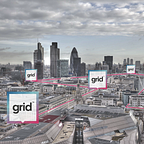Design at Grid, our five core principles.
Grid Smarter Cities decided to bring design in-house in 2016. Since then, the newly-formed design team have been working to embed design as a core function of the business. Design, for those unfamiliar with it, can sometimes be abstract and nebulous. Through reflection and critique of the last 12 months of activity, five core principles have been defined. These five principles guide the design team in their approach and also help the team to contextualise “Design at Grid”.
Design is strategic
Design is led by business goals. Design serves as a tool to inform, shape and achieve the business goals; determining objectives that shape tasks for the team.
Design is aesthetic
The design team delivers visual assets that elevate the company; bringing quality and consistency to Grid’s brand communication. The design team develop guidelines and systems to enable consistency.
Design is pragmatic
A sensible and practical approach to completing tasks.
Design is process-orientated
Design is a process to increase the level of detail about a particular subject; a product, a project, an experiment, an asset etc. The design team document and reflect critically on their process to evolve their practice.
Design is a facilitatory activity
The purpose of design is to facilitate and drive collaboration within Grid; within the product development team in order to achieve business objectives, working with business leaders to define and communicate the business objectives. A tool to interrogate options and inform decisions with challenge owners.
Note from the author -
We certainly don’t have all the answers so we happily welcome people’s thoughts and feedback. Also, we are currently working to materialise these principles in both print and digital formats so keep an eye out for that! Thanks for reading,
Nate Sterling
Design Strategist
